9 Tips You Need For Roasting Onions
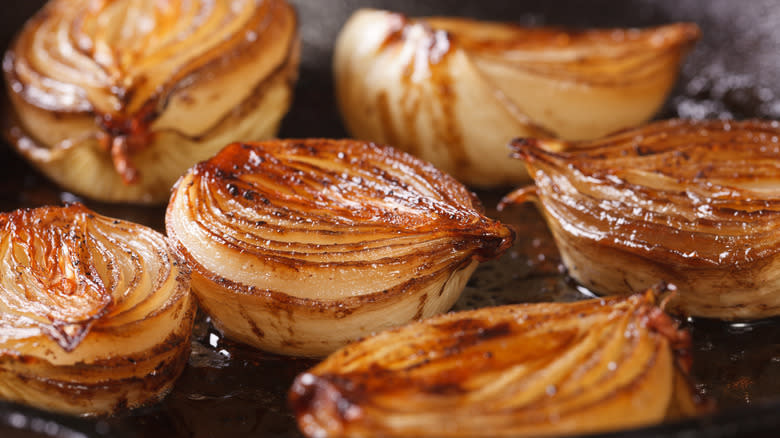
"Onions Roasting on an Open Fire" might not be a hit holiday humdinger, but one advantage onions enjoy is that many varieties are roasted all year round. From red, white, or yellow, these bulbs have permanent places at any grocery market and most kitchen pantries. Whether sautéed to top a succulent burger, cooked to accompany a tender cut of liver, or mixed into a luxe caramelized dip, onions are a flavorful addition to almost any meal.
For those who don't like the stinging bite of raw onions, roasting them to mellow out the sharpness can win them over. Roasted onions are super easy to prepare and cook, but keep in mind there's more to this dish than just tossing them into the oven and turning up the heat. Selecting the ideal bulbs, deciding on how long to roast them, and accessorizing this entree with the right spices are crucial to turning out delectable, tender onions at the perfect hue. Whether you're an onion devotee or a novice to this comfort food, here are some tips for roasting onions for any occasion. And these insider hints might just pull your chestnuts out of the fire.
Read more: The 14 Absolute Worst Mistakes You're Making With Meatloaf
Select Your Onions
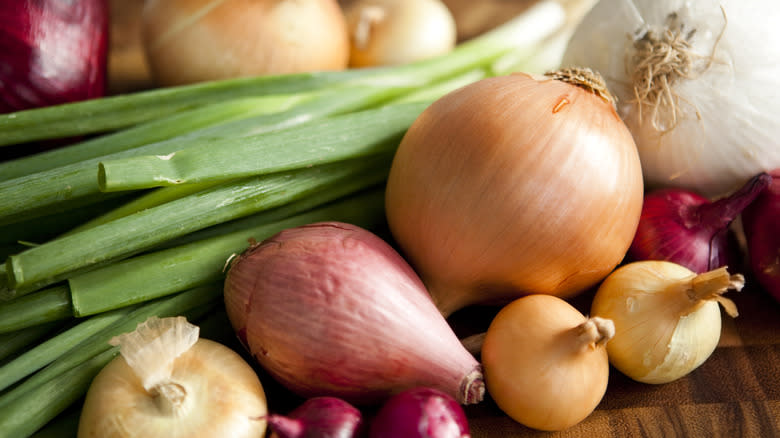
Any onion is eligible for roasting, but choosing the right onion is a crucial first step. The most popular types of onions are red, yellow, white, and assorted green onions, and each type has a unique aroma and flavor. Among its red and yellow cousins, white onions have the mildest taste due to their high water content. Red onions are a step up in terms of its sharp taste and aroma, while shallots and green onions run the gamut from sweet to mild.
As the National Onion Association points out, yellow onions are the "all-purpose" workhorse of the entire onion family. Yellow onions boast a powerful pungency and biting flavor that brings tears more readily to the eye than any of their other colored varieties. Their strong bite comes from their high sugar content, and when heat is applied, the sugar is left behind as moisture evaporates. The mouth-watering result? A sweet roasted onion with an intense golden brown tone. One guide to cooking with onions assures that, whether caramelizing, sautéing, or sweating out their moisture in a slow roast, yellow onions are often the go-to option for recipes that call for some onion lovin'.
Master Onion Cooking Techniques
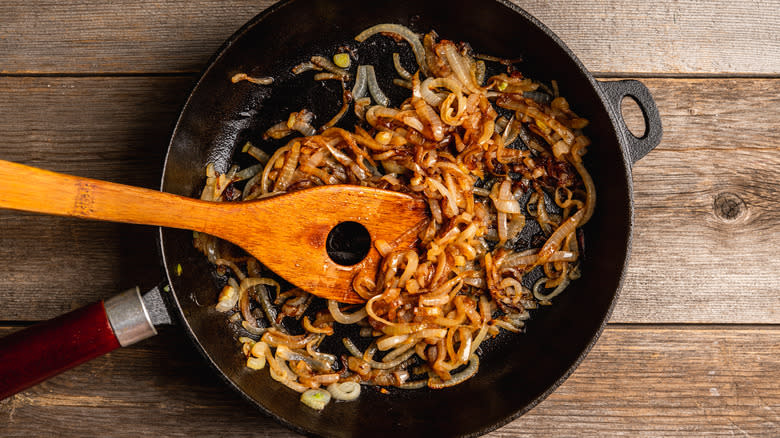
How d'ya like them onions cooked? Well, take your pick. Onions are versatile when you turn up the heat, and differing techniques lead to changes in flavor and texture. So adjust your internal roast-o-meter and synchronize your time clocks when deciding on exactly how to prep your dish. Sautéed onions, for instance, are cooked over high heat for a short period of time. They retain most of their moisture and their shapes. In contrast, caramelized onions are cooked over low heat for a longer period of time. Their flavor is mellow, and the texture is mushier.
Onions can be caramelized in a skillet, but roasting them in the oven is easier and more convenient. Cooking with a skillet requires standing over a hot stove, constantly stirring to avoid charring. In contrast, roasted ovens can be basically left alone in an oven, with a turn at the halfway point. An oven's larger capacity is also a plus when prepping a more complicated dish, like a pot roast. When baking a pot roast, add some yellow onion wedges into the baking pan to sweeten the entire pot. As the onions caramelize, the released sugars will add that special zing to its accompanying meat and other vegetables.
Cutting Onions Can Control The Taste
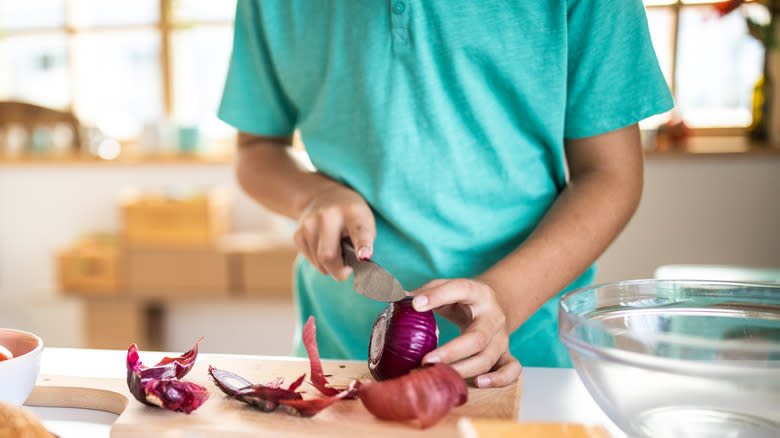
There's more to cutting an onion than just holding back the sniffles. Most of us opt to slice off the head and end, and some additional expert tips for cutting onions include directing the knife along the bulb's striations to prevent the juices from escaping and eyes from watering.
But before you begin chopping away, keep in mind that onions can be roasted whole, halved, wedged, sliced, or diced. Onions are 89% water, which evaporates when they are cooked. In addition, cutting onions releases its internal flavor; the more you swing your knife at an onion, the greater its pungency heightens, and the bulb dries out more quickly. This will affect the onion's cooking time and its final texture.
So, depending on your main dish or using onions as a standalone meal, you might want to keep your onion whole or use a sharp knife to slice into wedges, rings, or anything in between. If you're craving the aroma of onions, the right way to slice onions is to create thin slices, cutting against the grain to release more juices. If you prefer a more mild onion flavor, arrange the bulb into larger wedges or just keep it entirely whole.
Give Your Onions Plenty Of Time

As noted above, the variety and the cut of an onion will affect how you cook it. In general, roasting onions is an art that shouldn't be rushed. One top tip for cooking onions is to have patience, and we don't mean just waiting for the oven to preheat to a minimum of 400 degrees F. Onions need time to release its moisture before the caramelizing process can begin. To get there, onions run through a series of stages, turning from solid color to translucent, then yellow, then golden brown. The whole process can take upwards of 80 minutes.
If you're short on time, you can speed up the process a bit by cutting them into smaller pieces. A whole onion will take at least an hour to roast, but wedges and quartered onions can be ready in as little as 35 minutes. Or, start off small, to begin with, by avoiding large onions at the grocery market. The smaller the onion, the less volume of water it contains, and this will reduce the time it spends in the oven.
Don't Remove The Onion Peel
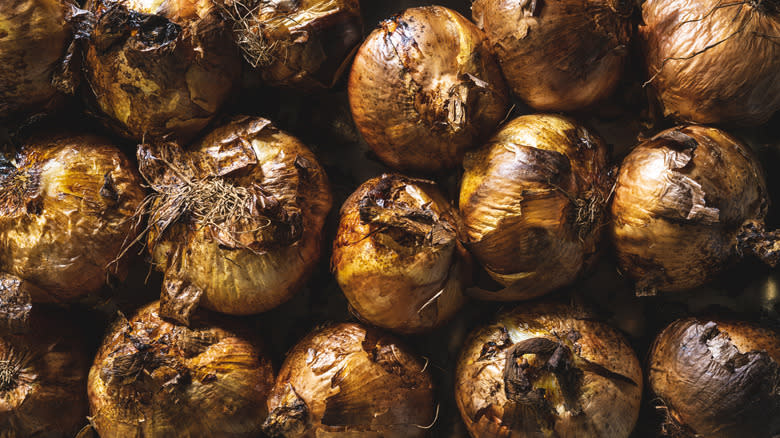
At an initial glance, an onion's peel doesn't look appetizing. This papery, dry, and flaky layer is usually one of the first things to go when prepping onions. After all, we don't even eat the onions' outer skin after they are cooked and ready to serve. Even worse, they might be sticky and messy from all the added seasonings and oils. So why not skip ahead and toss the peels out before putting them in the oven?
You should definitely remove the heads and ends to stop the onions from rolling in the baking pan, but keep the rest of the peels on. These snug jackets can keep some of the bulbs' surface moisture from evaporating too quickly. That might seem counter-intuitive since, normally, we want onions to sweat out its water content. But if the onion does this too quickly, the dry outer layers get toasted while the core remains raw. The onion's peel protects the outer layers from burning too quickly during the caramelizing process. Protecting your onions in their peels can ensure they're evenly cooked.
And one insider hack for roasted onion peels: They pack amazing flavor. Even though you don't eat them, don't throw away your onion peels. Save the peels to add to a soup base, or use a food processor to powderize them into a fine seasoning to accentuate your favorite meat and veggie dishes.
Select Oils And Seasonings

There's no end to ways to spruce up your roasted onions. While roasted onions already have a mushy texture and a matching mellow sweetness, mixing in some seasoning and oils can elevate the umami to the next level. One basic tip you need is to sprinkle some salt on top of the onions before putting them into the oven. The salt not only creates a tangy, sweet and salty taste, it also absorbs your onions' inner moisture, accelerating the caramelization time.
Many ready recipes call for adding olive oil, peppers, thyme, rosemary, and garlic. But for anyone with adventurous taste buds, we recommend swapping out the olive oil with avocado oil, which has a higher smoking point, which means it can withstand higher temperatures without breaking down. If you're aiming to savor a pure onion taste, avocado oil has a more subtle taste than olive oil. For fruit fanatics, try topping your onions with cherries and roasting them together; roasted cherries have a rich, juicy flavor, and this sweet combo will seem like a meal — and dessert — unto itself.
Keep Some Broth Handy
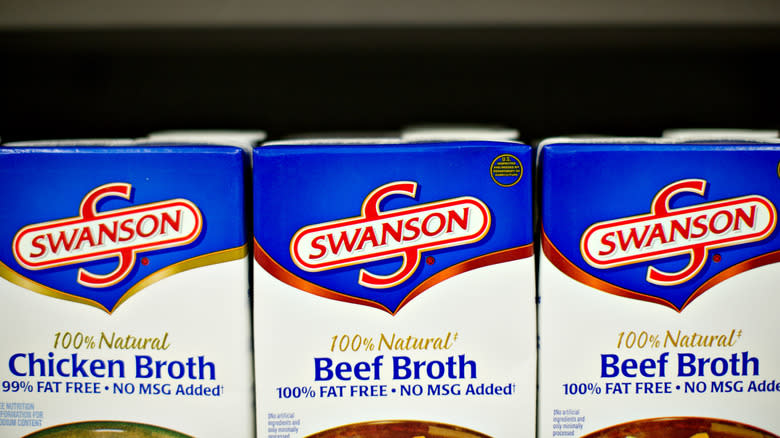
Crispy roasted onions are great, but one risk is that they might completely dry out when in the oven. Some experts suggest adding oil or butter to help keep the onions from drying out, but oils can up the cholesterol and calories. One healthier option to foolproof your recipe when caramelizing your onions is to add a dab of broth instead. Broth can help the onion retain moisture and not get burnt while increasing the flavor.
Of course, you can simply amp up the overall taste by simmering the onions in the broth directly while they're roasting. After the onions have been baking for 30 minutes, pour some broth on and around the onions and some additional seasoning — soy sauce works wonders — to rejuvenate the lost moisture and intensify the caramelization. While simmering, sprinkle in some mild cheddar cheese to make a crust or prepare some garlic rolls for dunking. Think French onion soup taken to the next level.
Prepare Your Kitchenware
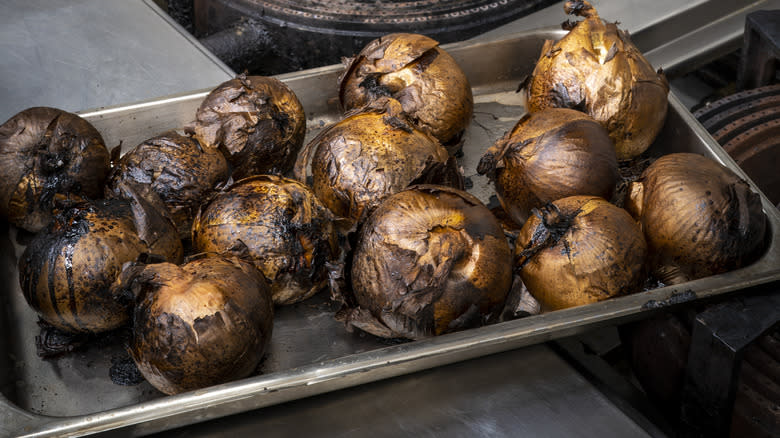
If you're roasting sliced onions, a simple baking sheet might suffice. Just make sure the slices are spread apart for easy roasting. When checking on sliced onions or smaller wedges, use a tong to flip 'em over to ensure they're evenly cooked.
For heavier portions, like larger wedges, halves, and whole onions, a baking sheet might be too flimsy. A weak sheet also allows a lopsided whole onion to start rolling its way toward the kitchen floor. If you're adding any seasonings and flavors, like drizzling oils or a broth base (as mentioned above), you definitely don't want a shallow edge on your baking sheet that can invite gravity to do its thing. Consider investing in a sturdy roasting pan that can support the weight and, equally important, so you'll feel comfortable carrying it. The roasting pan also does double duty in absorbing and distributing the heat within its enclosed space to maximize your roasting power.
If you're prepping them ahead of the serving time, wrap the onions in aluminum foil. The foil will help retain and distribute heat as it awaits your guests. Aluminum foil is also handy when you're roasting large whole onions in the oven. Should the outside layers caramelize too quickly while the core is still taw, placing a sheet of foil over the baking pan can prevent the edges from being cinder while the onion continues to cook.
Try Using An Air Fryer
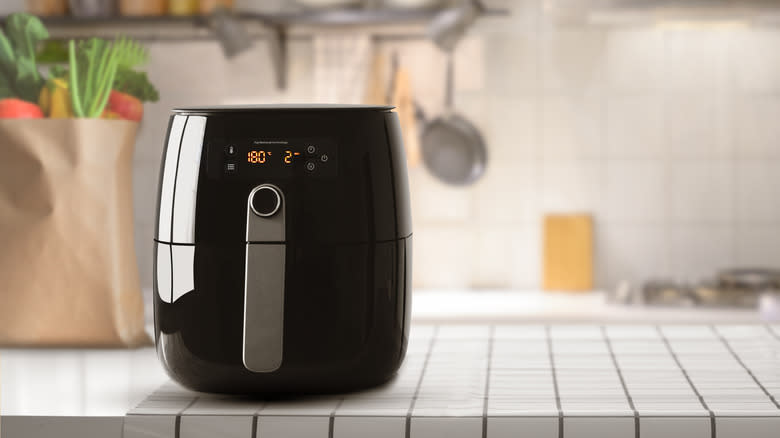
Traditional recipes call for roasting onions in the oven. But try using an air fryer instead. You can already use an air fryer to make the best onion rings, and roasted onions are no exception. The air fryer can cut down the baking time from over an hour to about 10 to 20 minutes, with rotating at midpoint. You'll also shave off precious minutes in pre-heat time and your carbon footprint by avoiding warming up the entire kitchen.
One caveat to using air fryers is that many of the smaller countertop units don't have large spaces in their drawers to hold lots of food. If you're planning on roasting onions as part of a larger course, like a roast, you won't have room for all the ingredients, which means less caramelized flavor in the final dish. Air fryers can also increase your food's calorie count when you add oil and other fats to fry the food. While roasted onions typically call for oil anyway, bear in mind that oven-roasted dishes tend to have fewer calories than their air-fried versions. But regardless of the kitchen gadget you use, you'll still wow 'em at the table, leaving all guests nodding in agreement that you know your onions.
Read the original article on Tasting Table.

 Yahoo Lifestyle
Yahoo Lifestyle 
